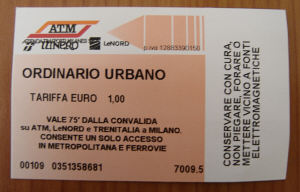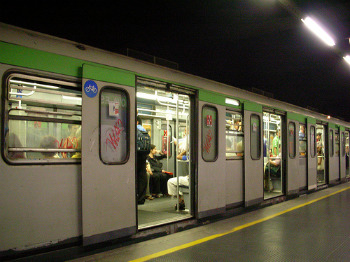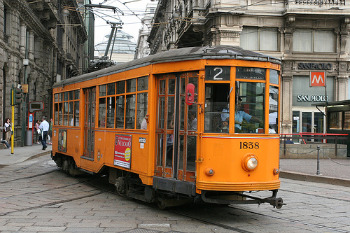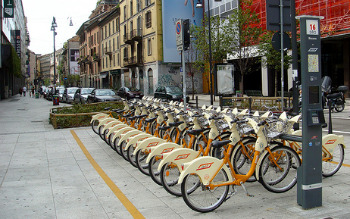How to Get Around in Milan: Milan Public Transportation 101
 I’ve written before about how to get around Venice and how to get around Rome, two cities that are both incredibly popular with visitors and where the transportation options might seem a bit confusing or overwhelming.
I’ve written before about how to get around Venice and how to get around Rome, two cities that are both incredibly popular with visitors and where the transportation options might seem a bit confusing or overwhelming.
Despite the fact that Milan doesn’t get the number of tourists that Venice and Rome do, however, it’s a stop on many itineraries for two reasons – to see “The Last Supper” and because people often fly in and out of Milan Malpensa Airport. So here’s what you need to know about public transportation in Milan.
Milan’s city center, where most tourists spend their time, is quite compact and – if you like to explore on foot – easy to walk in. It’s also blessed with three major modes of public transport that form an excellent network throughout not only the city center but neighborhoods further out as well. It’s quick and cheap to get around on Milan’s public transportation system, and it’s not difficult to figure out, either.
>> To get around the city of Milan first you need to get into the city itself! Here’s how to get to Milan from Malpensa Airport.
How to Use Public Transportation in Milan
Types of Public Transportation in Milan
As long as you’re not renting a car in Milan (and really, there’s not much reason to rent a car in any of Italy’s big cities), that leaves you with three major forms of public transit.
- Metro – Like many big cities around the world, Milan has a subway system. It’s not as huge or extensive as the subways in Paris, London, or New York, but the three lines serve almost all the tourist stops in the city (as well as plenty of other places besides).
- Tram – The other main rail-based transport in Milan is the city’s network of trams. There are more tram lines than subway lines, and depending on where you are in the city these can be really convenient to get where you’re going.
- Bus – Milan’s buses cover many of the same areas that the Metro and trams do, but they also go a bit further afield than those other two transportation methods.
There is also a bike sharing program in Milan called BikeMi, and although it’s not specifically geared toward tourist use it’s possible to use the bikes even on a short day-long visit to the city.
And in addition to Milan’s Metro, there are also some urban and suburban railway lines that may come in handy if you’re visiting neighborhoods a bit further from the city center. (There’s more about these lines at the bottom of this article.)
Tickets for Milan Transportation
 This section covers public transportation within the city center as defined by Milan. The tickets covering this section are called “Urban” Tickets. See this page of the ATM site for more information about the different tickets that cover destinations outside the city center.
This section covers public transportation within the city center as defined by Milan. The tickets covering this section are called “Urban” Tickets. See this page of the ATM site for more information about the different tickets that cover destinations outside the city center.
All of the major forms of public transit within Milan are operated by the same company – the Azienda Trasporti Milanesi, or ATM (in other words, when you see the letters “ATM” on a sign, that’s not indicating a bank machine!) – which makes it really convenient in terms of buying tickets. The Metro, tram, and bus use the same exact tickets.
An individual ticket costs €1.50 and is good for 90 minutes. If you change buses or tram lines within the 90-minute span of time after you first validate your ticket, you can make that journey on one ticket. You can change Metro lines on one ticket, too, but as soon as you leave a Metro station you can’t use the same ticket on the Metro again – each ticket can only include one Metro trip.
There are two multi-day tickets you can buy (€4.50 for a 24-hour pass or €8.25 for a 48-hour pass), and you can also buy a 10-journey ticket called a “carnet” (pronounced kar|NAY, borrowed from the French) for €13.80. The weekly pass only entitles you to two trips per day for six days within one week, but if you think that’s all you’ll need it’s a cheap €8.40.
You have to validate your ticket before each use (with a 24- or 48-hour pass you only need to validate it once at the beginning), and be prepared to show your ticket to the inspectors that board trains, trams, and buses periodically (or risk a fine).
There is a stipulation on the ATM website that you purchase a “luggage ticket” if you’re bringing luggage onto a Metro train, bus, or tram – but the site doesn’t provide information about whether there’s a size above which luggage must be ticketed. If you’re concerned about it, a luggage ticket is €1.50 and valid for 90 minutes (or you can ask someone at a ticket window, when you find one that’s staffed).
Riding the Metro in Milan
 If you’re accustomed to riding the subway in cities like Paris or London then the Metro in Milan will be pretty easy to figure out. There are three lines, each with its own color desgination and number. M1 is the red line, M2 is the green line, and M3 is the yellow line.
If you’re accustomed to riding the subway in cities like Paris or London then the Metro in Milan will be pretty easy to figure out. There are three lines, each with its own color desgination and number. M1 is the red line, M2 is the green line, and M3 is the yellow line.
To determine the direction you need to go on any line, find the station you want to go to on the Milan Metro map. If you continue tracing the line past your station to the station at the end of that line, you’ll know the “name” of the direction you need to head toward. Keep in mind that the red and green lines each split at one end, however, so if your stop is on one of the legs of the Y you need to pay more attention to which station name is at the end of that line.
There are more details about how to figure out your route in my article about how to use the Milan Metro.
Riding Trams in Milan
 There are 19 tram lines in Milan, and the trams on them range from the yellow/white and orange 1920s era trains to new green trains. The old trains can be more fun, with their wooden bench seats and old-fashioned look (there’s even a moving restaurant on an old tram called the ATMosfera!), but the newer trains tend to be larger and offer more seating.
There are 19 tram lines in Milan, and the trams on them range from the yellow/white and orange 1920s era trains to new green trains. The old trains can be more fun, with their wooden bench seats and old-fashioned look (there’s even a moving restaurant on an old tram called the ATMosfera!), but the newer trains tend to be larger and offer more seating.
On many transit maps in Milan, tram lines and bus lines are indicated in the same manner, since they’re both above-ground transportation. You can get an idea of which ones are tram lines by looking at the number – trams have most of the numbers from 1-33 (18 is a bus line, but that’s the only exception).
Tram lines have names in addition to their numbers, and like the Metro the names of the lines are determined by the stations at either end of the line. The direction you’re going is named for the station at the end of the line. In other words, you’ll need to know not only the number of the tram you’re looking for but also have a list of the stops it makes in order to figure out which direction you need to go.
Unlike the Metro, trams won’t necessarily stop at every point along their route. You’ll need to push the button or pull the cord in order to request the tram stop at the next point so you can get off, and if you’re waiting at a tram stop that’s served by more than one line you should step toward the edge of the curb when you see a tram with the number you want on the front so the driver knows you want to get on.
Note that in some cases the tram’s rail lines won’t be right next to the sidewalk where the tram stop might be. Sometimes there’s a lane for cars between the sidewalk and where the tram will stop. Just make sure there aren’t any cars coming before you step off the curb.
Riding Buses in Milan
 Riding the bus in Milan isn’t a challenge if you’ve ever ridden a bus in another city. The thing that sometimes makes the bus less appealing to tourists is that if you’re not familiar with a city you may not know when to get off the bus you’re on. The Metro stops at every station – buses don’t pull over at every stop on their route.
Riding the bus in Milan isn’t a challenge if you’ve ever ridden a bus in another city. The thing that sometimes makes the bus less appealing to tourists is that if you’re not familiar with a city you may not know when to get off the bus you’re on. The Metro stops at every station – buses don’t pull over at every stop on their route.
There are 79 bus lines in Milan, so if your hotel or the attraction you want to see isn’t near a Metro station or a tram stop then it’s likely there’s a bus stop nearby. Like the trams in Milan, bus lines have numbers and names, and the names correspond to the two stations at either end of that line. After you determine the bus line you need, you’ll need to trace the route to the end of the line to see what the direction you need is called.
Bus stops in Milan aren’t always easy to spot, because they don’t tend to be shelters the same way that many tram stops are sheltered. Keep an eye out and you’ll start to notice poles with signs that have bus numbers and stops listed for each line that stops there. The name of the stop you’re standing in front of will typically be highlighted or outlined on the list of stops.
Buses only stop if there’s someone waiting to board that bus, or someone on the bus who needs to get off. If you’re at a stop that’s served by multiple bus lines, look for the number of the line you want at the top of the bus. When you see your line, step toward the curb to indicate to the driver that you’re waiting for that bus. If you’re on the bus, press one of the buttons on board to request that the bus stop at the next point on the route.
Other Modes of Transportation in Milan
Along with the three major methods of public transportation in Milan that are outlined above, there are two others that may come in handy depending on how long you’re staying in the city and where your accommodation is.

- Bike Sharing – Milan’s bike sharing program is called BikeMi, and there are stations throughout central Milan. Once you’ve signed up, you punch in your code and select a bike from the available ones at that station. You can sign up for the program, check a station in advance to see how many bikes are available there, and find out where all the BikeMi stations are on the official website.
- Suburban Rail – At some underground stations, you’ll see blue signs with a green S on them. These are suburban rail lines (the S lines), and although they do serve some of the same places as the regular Metro lines they also go beyond the Metro network in some cases and serve some areas the Metro does not. On a Metro map, the S line is a blue line, and as long as you’re staying within the main part of the city it uses the same ticket as a regular Metro trip.
Milan Transportation: Additional Resources
The official ATM website has an extensive English version, so you should be able to find out the answers to most of your questions on the site. Also note that there’s a very cool route planner on the ATM site, where you can enter your starting and ending addresses and the site will generate a transportation map for you to follow. If you know what time you’ll be departing, it will even tell you roughly how long you’ll wait for the next Metro/tram/bus.
- Official ATM Website
- ATM Network Map (PDFs)
- GiroMilano Route Planner
- Details About ATM Tickets
- Transport Timetables/Calendar (including seasonal schedules)
photos, top to bottom, by: beggs, Jessica Spiegel, Alessandra Cimatti, zoonabar, lettera27, catorze14